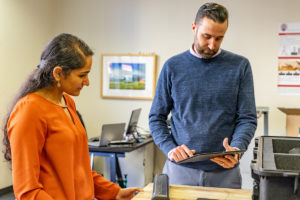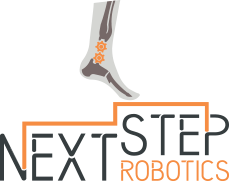About NextStep Robotics
 The NextStep Robotics team has used their years of experience in using novel robotic solutions in the field of neuro-rehabilitation to create a game-changing robotic ankle training device to rehabilitate patients that have foot drop because of stroke and other disease conditions.
The NextStep Robotics team has used their years of experience in using novel robotic solutions in the field of neuro-rehabilitation to create a game-changing robotic ankle training device to rehabilitate patients that have foot drop because of stroke and other disease conditions.
Until now, conventional care for injuries resulting from foot drop were intensive physical therapy, and thereafter, uncomfortable orthotics or assistive devices. The AMBLE device developed by NextStep Robotics is unlike anything available on the market today.
Our Purpose
NextStep Robotics has an overarching purpose: combine robotics and information technology to provide movement-based therapy to alleviate foot drop by improving voluntary control of the affected ankle. Our signature device, the AMBLE, is designed to provide step-by-step graded assistance that over time, is progressively reduced as the patient’s foot drop severity improves. Unlike substitutive devices like prostheses, our device is intended to alleviate the workload of physical therapists while maximizing mobility outcomes for patients with foot drop. We are committed to enriching patients’ lives.
Our History
The NextStep Robotics team has worked for almost a decade to improve the lives of patients who require a forward-thinking physical therapy device to enhance their quality of life. They have successfully raised over $1M to help launch this young start-up business with a longstanding collaborative history between the co-founders. The NextStep Robotics team combines the expertise of a clinical research specialist, a stroke neurologist, a robotics engineer, and a human movement scientist, who have nearly two decades of experience conducting rehabilitation research and clinical trials, both with and without robotic devices. The result is a technological innovation that is a versatile robotic physical therapy device, neurological device, and a training device all in one.
Our Team
Brad Hennessie – CEO – Brad is a former Lead Clinical Research Specialist from the University of Maryland, Baltimore, and is now leading the charge to commercialize this device and provide physical therapists a novel approach to effectively and durably reduce the adverse or potentially adverse effects of foot drop. Working with his co-founders for almost a decade, he has successfully raised over one million dollars to launch their young start-up.
Rich Macko, MD – CSO – Dr.Macko is a neurologist and professor of neurology at the University of Maryland, Baltimore, where he is a leading expert in stroke recovery. Dr. Macko has published over one hundred fifty peer-reviewed research articles in the field of stroke neurorehabilitation. Dr. Macko has over 20 years of experience including as the Director of the VA Rehabilitation Research and Development Center of Excellence in Exercise and Robotics in developing and testing disability and disease specific exercise training models that combine motor learning with exercise rehabilitation including lower-limb robotics to improve functional mobility for individuals with stroke and other chronic mobility disability conditions associated with advancing age. Dr. Macko has extensive experience in successfully obtaining state and federal grant funding.
Anindo Roy, PhD – CTO – Dr. Roy is the engineer behind it all, developing the control system embedded in our robotic device that is critical to safe and effective ankle training in the context of walking. With extensive experience and training in rehabilitation robotics at MIT, Dr. has a unique perspective and skillset in translating therapy needs into robotic solutions. Dr. Roy leads all efforts in engineering including integrating robotics into the recovery pathway and generating new intellectual property. Dr. Roy has adjunct faculty appointments in both the University of Maryland school of medicine and in the James Clark School of engineering.
Larry Forrester, PhD – Resident Scientist – Dr. Forrester is the recently retired Director of the Baltimore VA Human Motor Performance Laboratory. Larry has nearly two decades of experience conducting rehabilitation research focused on therapeutic interventions to improve movement function after stroke and other neurological diseases.
What’s Next for the NextStep Robotics Team
NextStep Robotics has a bright future on the horizon. They are hiring, taking on interns, and even looking into how they can expand into other market channels. NextStep is also planning to branch out into other technologies that will improve the lives of patients such as upper extremity robotic solutions, as well as refining and iterating their signature lower-limb robotic technology to best meet the needs of patients and physical therapists alike. Development efforts are already underway to build an AI-based repository to assess and assign training protocols optimized for each patient’s deficit.
NextStep Robotics was recently awarded a Phase II NIH $4.5 million cooperative agreement to bring its stroke recovery device to market. Read more about NextStep Robotics’ latest news for more information.

